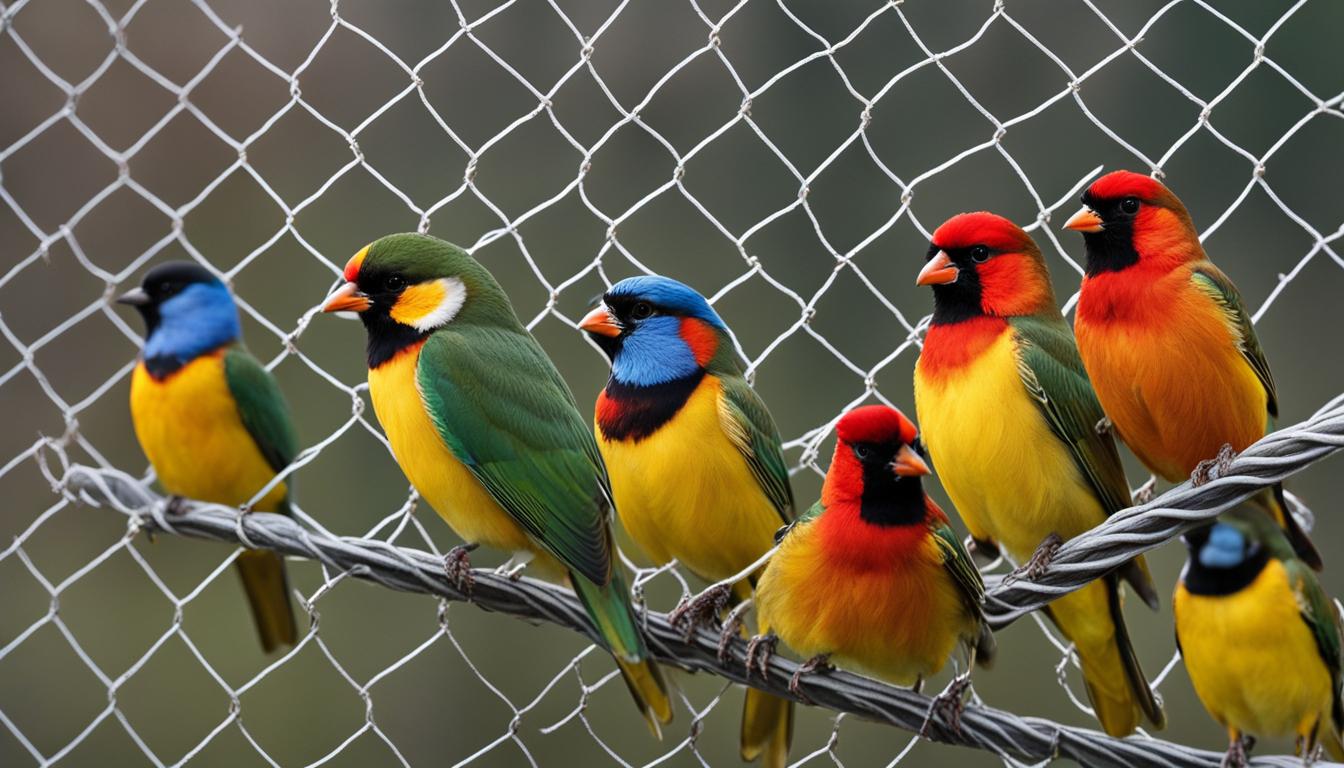Bird netting is a highly effective solution for protecting your home’s garden, crops, and ponds from unwanted avian visitors. By creating a physical barrier, bird netting prevents birds from accessing specific areas, ensuring the safety and integrity of your property. However, with various types of bird netting available, it is crucial to choose the right mesh size, net material, and installation method for your specific bird control needs.
When selecting bird netting, it’s essential to consider the different options and their advantages for specific applications. Whether you need bird netting for your garden, crops, or ponds, understanding the varieties available will help ensure optimal results. Let’s explore the key factors to consider when choosing bird netting for your home.
Key Takeaways:
- Types of bird netting include bird control netting, bird exclusion netting, bird deterrent netting, bird netting for gardens, bird netting for crops, bird netting for ponds, and anti-bird netting.
- The right mesh size is crucial for effective bird netting, as smaller mesh sizes deter a wider range of bird species.
- Net material impacts durability, installation complexity, and suitability for different environments.
- Garden netting is lightweight and perfect for seasonal bird problems, while heavy-duty netting is suitable for commercial or permanent installations.
- Bird netting is versatile, eco-friendly, and cost-effective, making it a reliable option for bird control in various settings.
Now that we’ve covered the basics, let’s dive into why bird netting is the best choice for your bird control needs and explore its various applications.
Why Bird Netting Works Best
Bird netting is considered one of the most effective bird control solutions. It provides a physical barrier that prevents birds from accessing specific areas, making it suitable for a variety of settings including home gardens, large agricultural areas, and warehouses.
Bird netting is not only effective but also safe for birds and environmentally friendly. It allows birds to see the mesh and avoid collision, ensuring their well-being. The netting is designed to last a long time and requires minimal maintenance once installed, making it a convenient choice for long-term bird control.
One of the advantages of bird netting is its availability at different price points, making it a cost-effective option for bird control. Whether you have a small garden or a large agricultural operation, there is a bird netting solution that fits your budget.
| Advantages of Bird Netting | Disadvantages of Bird Netting |
|---|---|
|
|
Overall, bird netting is a highly recommended option for bird control due to its effectiveness, safety, longevity, and cost-effectiveness. Whether you need to protect your garden, crops, or ponds, bird netting provides a reliable solution that keeps unwanted birds at bay.
Bird Netting Testimonial:
“I’ve been using bird netting in my vineyard for five years now, and I can confidently say that it has been the best investment for protecting my grapes. The nets are easy to install and have significantly reduced bird damage without causing harm to the birds. I highly recommend bird netting for any agricultural operation.” – Jane Smith, Vineyard Owner
Importance of Mesh Size in Bird Netting
When it comes to bird netting, the mesh size is a critical factor in determining its effectiveness. Smaller mesh sizes are more efficient at deterring a wider range of bird species, ensuring comprehensive bird control.
Choosing the correct mesh size depends on the types of birds you want to exclude from your property. It is essential to consider the size of the birds in your area and select the smallest mesh size that will still effectively block them.
“The smaller the mesh, the better the control.”
| Mesh Size | Suitable for |
|---|---|
| 3/4″ | Birds of smaller size, such as sparrows and finches |
| 1 1/8″ | Medium-sized birds, including pigeons and starlings |
| 2″ | Larger birds like seagulls and herons |
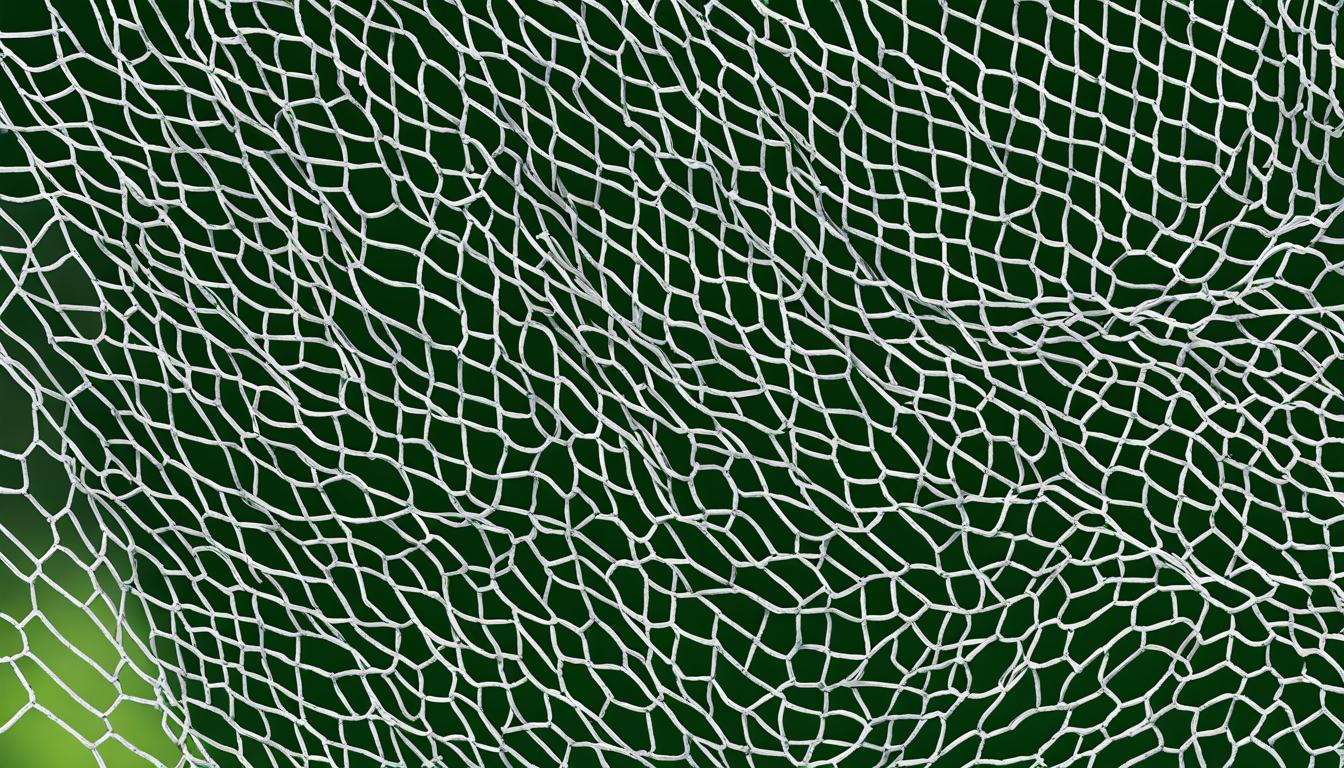
By offering a range of mesh sizes, Bird B Gone provides the flexibility to tailor the bird netting to your specific needs. Whether you require bird netting for gardens, crops, or ponds, selecting the appropriate mesh size is crucial for optimal bird control.
Remember, when it comes to bird netting, size matters. Choose the right mesh size to keep unwanted avian visitors at bay and protect your property.
Different Types of Bird Netting Materials
Bird netting is an essential tool for bird control, and it is made from different materials to suit various applications. Each material has its own characteristics and advantages, making it important to choose the right type for your specific needs. Here are some common bird netting materials:
Polyethylene Bird Netting
Polyethylene bird netting is a popular choice for both residential and commercial use. It is lightweight, UV-resistant, and durable, making it suitable for long-term installations. Polyethylene netting is tear-resistant and can withstand harsh weather conditions, making it a reliable option for bird control. It is commonly used in gardens, crops, and fish farms.
Polypropylene Bird Netting
Polypropylene bird netting is another widely used material in bird control. It is lightweight and easy to handle, making installation quick and hassle-free. Polypropylene netting is durable and resistant to environmental factors such as UV rays and moisture. It is commonly used in gardens, orchards, and vineyards.
Nylon Bird Netting
Nylon bird netting is known for its strength and durability. It is often used in heavy-duty bird control applications where extra strength is required. Nylon netting has a high break strength, making it suitable for protecting large areas and preventing bird entry. It is commonly used in warehouses, commercial buildings, and industrial facilities.
When choosing the right bird netting material, consider factors such as the level of durability needed, installation complexity, and the specific environment where it will be used. By selecting the appropriate material, you can ensure long-lasting and effective bird control.
Garden Netting for Seasonal Bird Problems
Garden netting is a versatile solution for protecting your garden, fruit trees, and berry bushes from seasonal pest bird problems. Made of black UV-protected polypropylene, this lightweight plastic mesh provides an effective barrier against unwanted avian visitors. With different mesh sizes available, you can customize the netting based on the size of the birds you’re dealing with.
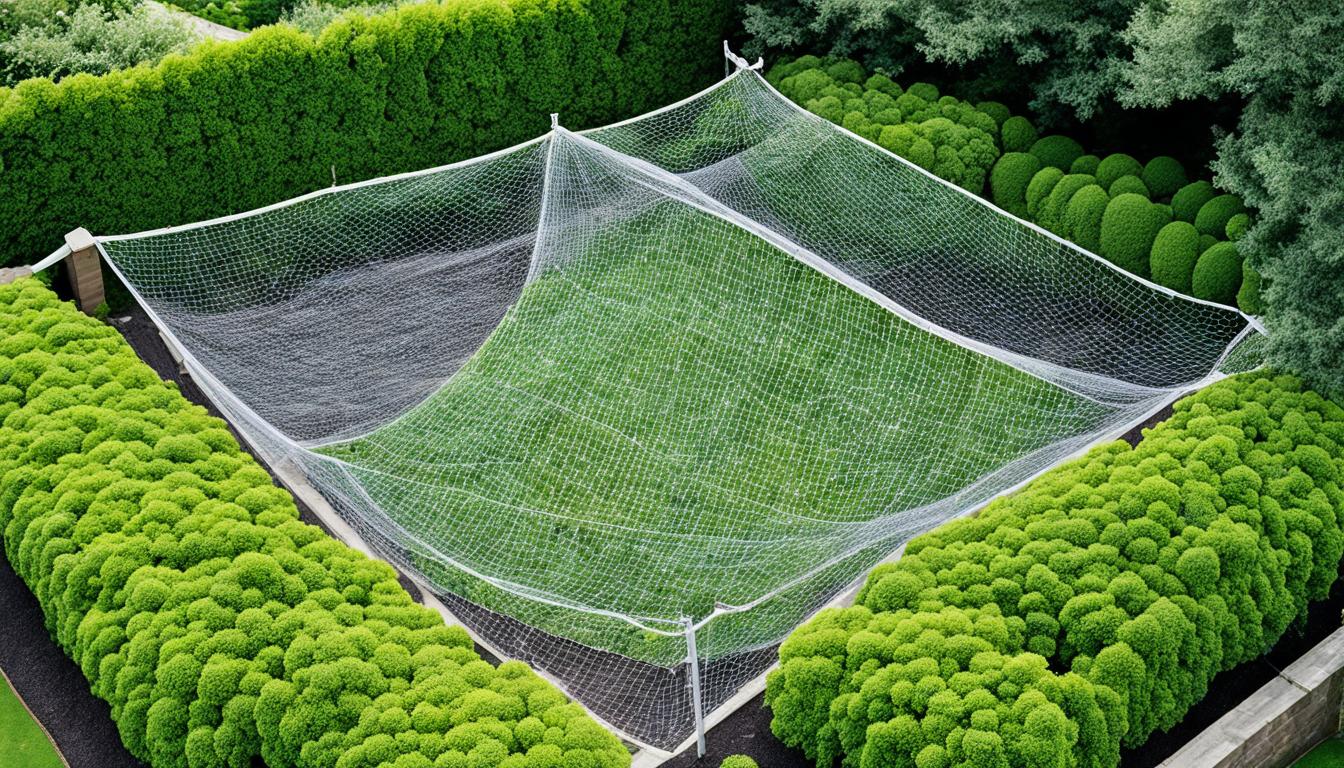
Garden netting is incredibly easy to use and can be effortlessly cut and trimmed to fit your specific needs using ordinary scissors. You have the flexibility to drape the netting over your garden plants or suspend it a few inches above the desired areas, ensuring comprehensive coverage and protection. By implementing garden netting, you can prevent birds from accessing your garden and causing damage to your crops.
| Benefits of Garden Netting | Considerations |
|---|---|
| ✅ Provides effective bird control | ⚠️ Requires regular inspection to ensure no gaps or holes |
| ✅ Lightweight and easy to handle | ⚠️ May not be suitable for larger areas |
| ✅ Customizable and adjustable | ⚠️ Requires periodic maintenance and cleaning |
| ✅ Cost-effective solution | ⚠️ Potential entanglement hazard for other wildlife |
Overall, garden netting is an excellent investment for protecting your garden from seasonal bird problems. It is an affordable and humane alternative to harmful repellents or pesticides, ensuring the safety of both your plants and the birds themselves. By implementing garden netting, you can maintain a bountiful and thriving garden while deterring unwanted avian visitors.
Heavy Duty Netting for Commercial or Permanent Installations
In commercial or permanent installations where durability and high break strength are essential, heavy-duty netting is the ideal solution. Bird B Gone offers a range of heavy-duty netting options, including Bird Net 2000, No-Knot Bird Netting, and Flame Bird Netting. These nets are specifically designed to withstand the demands of larger spaces and provide effective protection against pest birds.
Made from durable materials such as polyethylene and polypropylene, our heavy-duty nets are pressure-stretched and tightened for longevity. This ensures that they can withstand harsh weather conditions and constant exposure without sacrificing their effectiveness.
What sets our heavy-duty netting apart is its virtually invisible appearance once installed. This makes it an aesthetically pleasing choice for commercial settings where maintaining the overall appearance is crucial. Birds are effectively deterred from entering the protected area without compromising the visual appeal of the space.
The Benefits of Heavy-Duty Netting:
- Superior durability and high break strength
- Long-lasting effectiveness
- Resistance to harsh weather conditions
- Practically invisible once installed
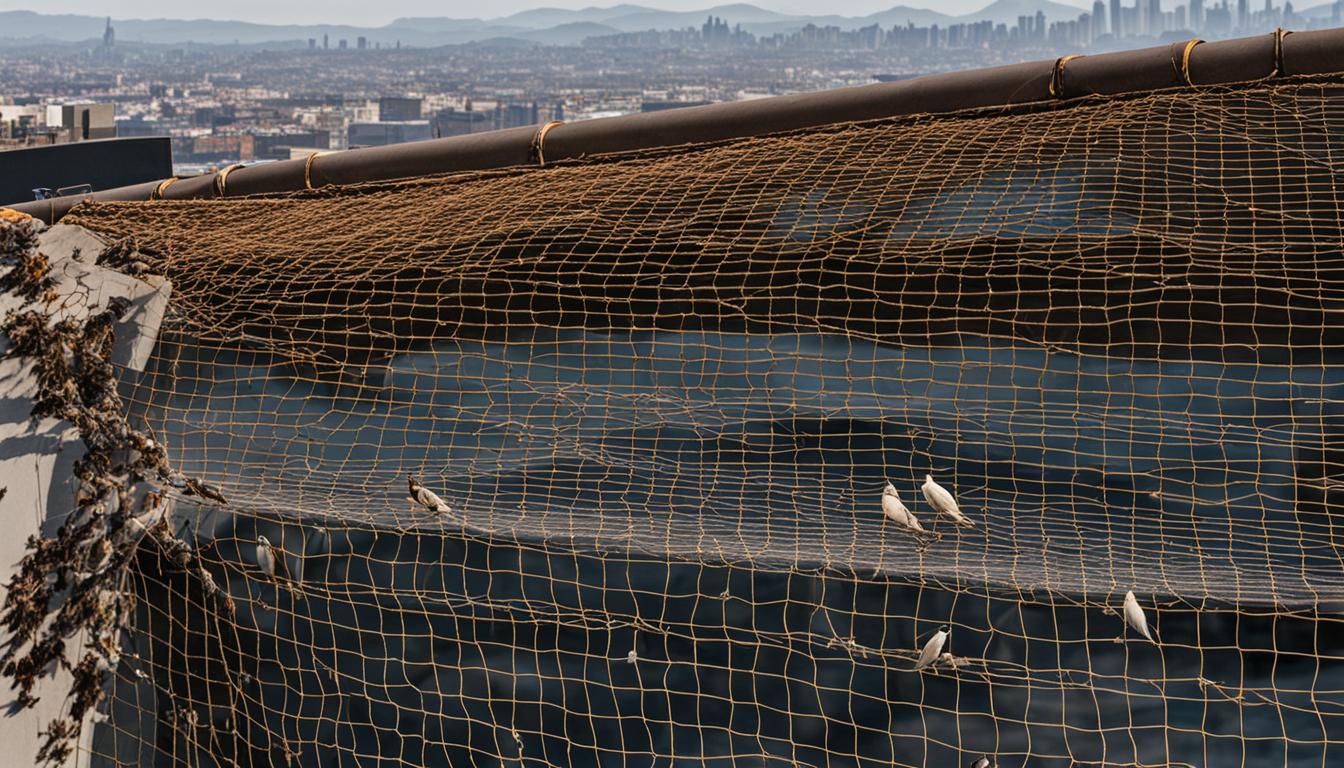
With our heavy-duty netting options, you can confidently protect your commercial or permanent installations from problematic bird infestations. Invest in quality bird control netting to maintain a bird-free environment while preserving the aesthetics of your space.
| Bird Netting Option | Material | Usage |
|---|---|---|
| Bird Net 2000 | Polyethylene | Commercial or permanent installations |
| No-Knot Bird Netting | Polypropylene | Commercial or permanent installations |
| Flame Bird Netting | Polyethylene | Commercial or permanent installations |
Invest in heavy-duty netting today and safeguard your commercial or permanent spaces from bird-related issues. Choose Bird B Gone for reliable and cost-effective bird control solutions that deliver results.
Bird Netting Applications and Uses
Bird netting is a versatile and essential tool for various applications, providing effective bird control in different settings. Here are some common bird netting applications and their uses:
1. Crop Protection
Bird netting plays a vital role in protecting crops from bird damage. By creating a physical barrier, it prevents birds from accessing plants and feeding on fruits, vegetables, or seeds. This is particularly important for agricultural areas where bird infestations can result in significant crop losses. Bird netting can be installed over cultivated areas, ensuring that crops remain safe from avian predators.
2. Fish Protection
In fish farms or ponds, bird netting acts as a protective shield, preventing birds from preying on fish. This is especially crucial in aquaculture settings where valuable fish stocks are raised. Covering the water surface with bird netting, not only safeguards the fish but also helps maintain optimal conditions for their growth and development.
3. Building Protection
Bird netting is also widely used to protect buildings from bird-related issues. It serves as an effective deterrent, preventing birds from nesting on rooftops, ledges, or other structures. By denying access to these areas, bird netting helps preserve the integrity of buildings, preventing potentially costly damage caused by bird droppings, nesting materials, and debris.
Additionally, bird netting finds applications in various other settings, such as:
- Protection of outdoor spaces like gardens, patios, or balconies
- Securing large warehouses or industrial facilities
- Preventing birds from entering sheds or barns
- Guarding against avian intrusions in commercial or public areas
Bird netting offers a versatile and efficient solution for bird control, ensuring that these feathered visitors stay out of restricted areas, protecting valuable assets, crops, and environments.
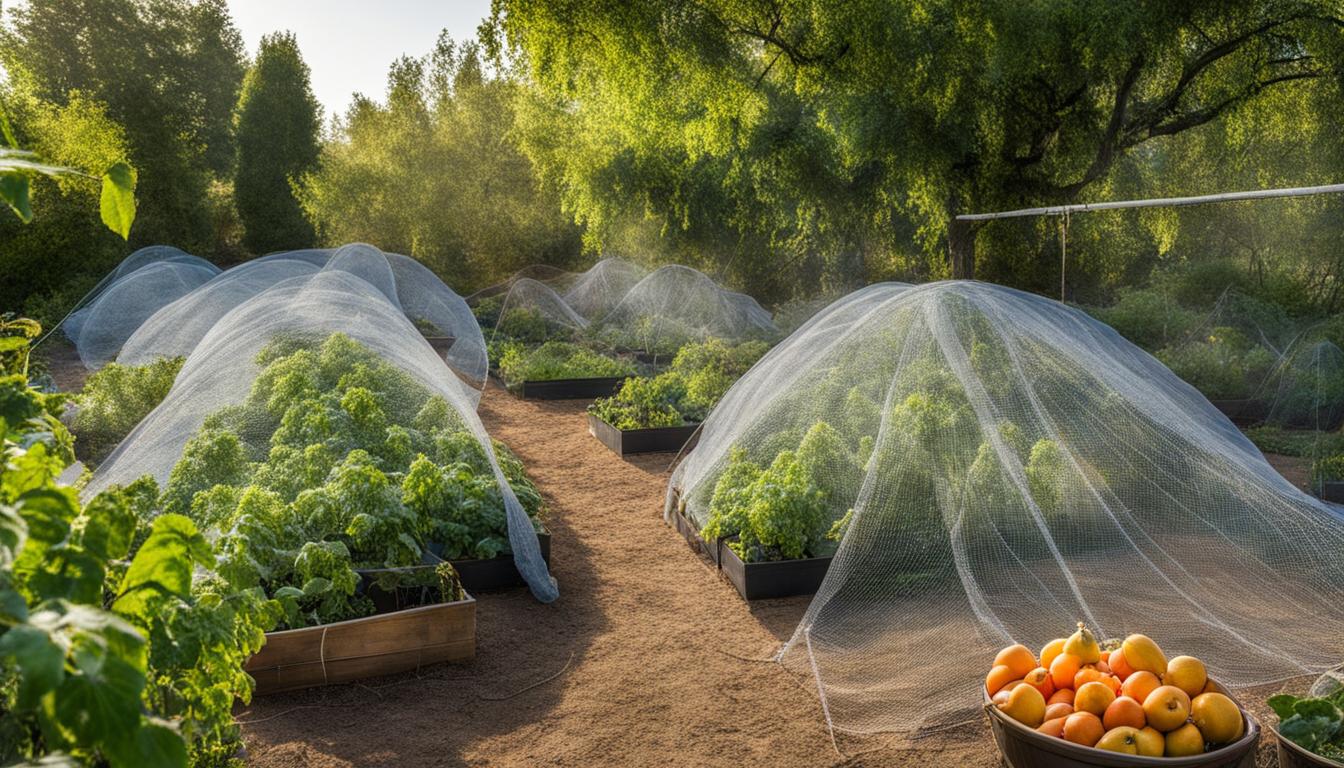
With its wide range of applications, bird netting provides an effective means of bird control in various settings. Whether it’s protecting crops, maintaining fish stocks, or safeguarding buildings, bird netting offers a reliable defense against avian intrusions.
How Bird Netting Works for Pigeon Control
Bird netting is a highly effective solution for managing pigeon populations and preventing them from accessing areas where they can obtain food and nest. Pigeons are naturally attracted to flat surfaces, such as ledges and roofs, for nesting and roosting. However, bird netting eliminates these opportunities by creating a barrier that denies pigeons access to these spaces, forcing them to seek alternative locations.
Pigeons are notorious pests that can cause significant damage to buildings, equipment, and crops. They leave behind droppings that not only create unsightly messes but can also corrode surfaces over time. Additionally, their presence can pose health risks, as their droppings can contain harmful bacteria and parasites.
By using bird netting for pigeon control, property owners can effectively deter pigeons from roosting and nesting on their buildings or other structures. The netting acts as a physical barrier that restricts access to flat surfaces, preventing pigeons from settling in these areas.
One of the key advantages of bird netting is its application versatility. It can be used in a variety of settings, such as recessed portions of buildings, light wells, under eaves, and around equipment. The netting is also suitable for other areas where pigeons may be a problem, such as balconies, terraces, and open spaces.
When properly installed, bird netting is virtually invisible, ensuring that the aesthetic appeal of the property is not compromised. It provides a long-lasting solution for pigeon control, requiring minimal maintenance once in place. Furthermore, bird netting is a humane method of addressing pigeon problems, as it does not harm the birds but simply deters them from accessing certain areas.
Benefits of Bird Netting for Pigeon Control:
- Prevents pigeons from nesting and roosting on buildings
- Reduces damage to structures and equipment caused by pigeons
- Minimizes health risks associated with pigeon droppings
- Preserves the aesthetic appeal of the property
- Provides a long-lasting and low-maintenance solution
- Does not harm the pigeons but deters them from specific areas
“Bird netting is an essential tool for protecting structures from pigeon infestations. It provides a humane and effective way to prevent pigeons from accessing areas where they can cause damage.”
To illustrate how bird netting works for pigeon control, take a look at the following image:
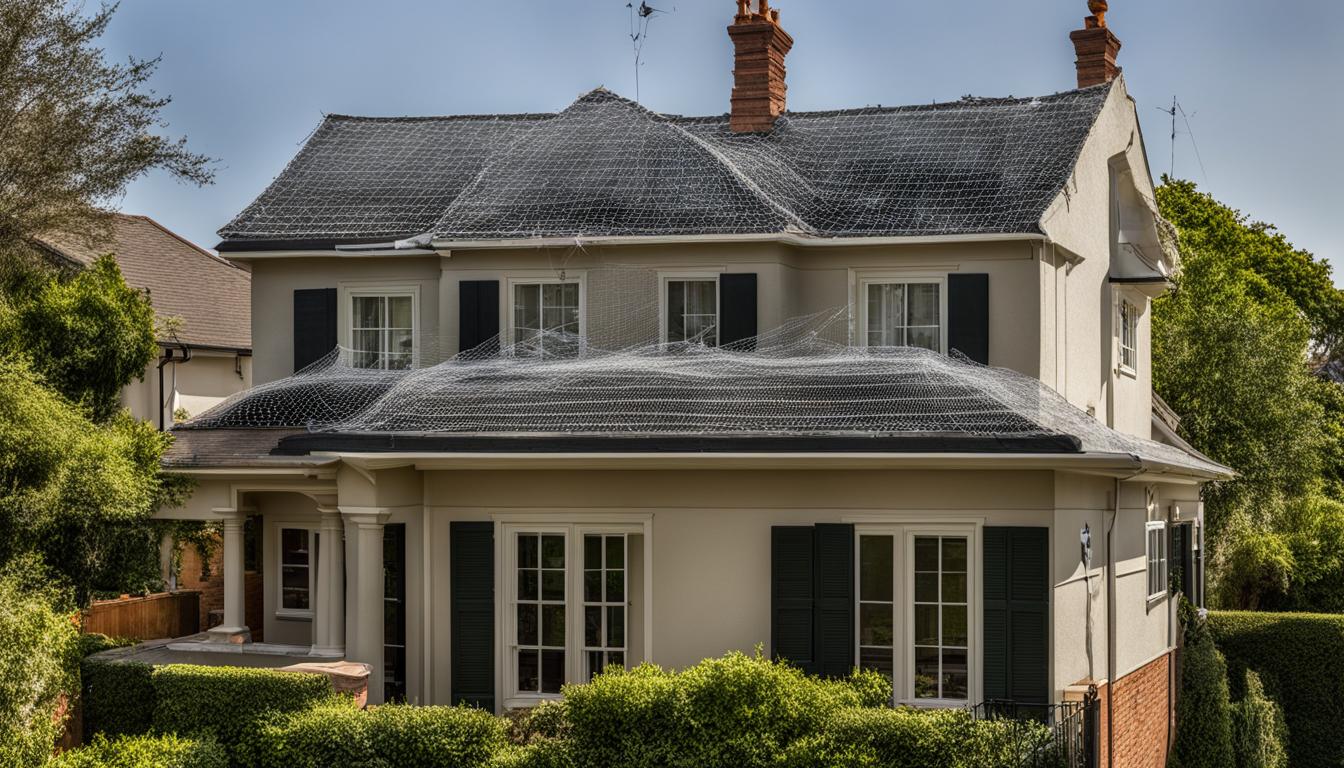
Next, we will explore the pros and cons of bird netting and discuss alternative methods of bird control that may be suitable in certain situations.
Pros and Cons of Bird Netting + Alternatives
Bird netting is a popular bird control method, but it’s important to weigh its pros and cons before making a decision. Here are some advantages and disadvantages of using bird netting, as well as alternative bird control methods to consider.
Pros of Bird Netting
- Suitable for Larger Areas: Bird netting is highly effective for covering larger spaces such as gardens, crops, and ponds, providing comprehensive bird protection.
- Long-lasting Effectiveness: When properly installed and maintained, bird netting can provide long-lasting bird control, reducing bird damage and nuisance over an extended period.
- Environmental Safety: Bird netting is an environmentally friendly bird control solution that doesn’t harm birds or other wildlife.
| Pros of Bird Netting | Cons of Bird Netting |
|---|---|
| Suitable for Larger Areas | May Become Counterproductive with Gaps or Holes |
| Long-lasting Effectiveness | May Not Be Cost-effective for Certain Facilities |
| Environmental Safety |
Alternatives to Bird Netting
While bird netting is a highly effective bird control method, there are alternative solutions available depending on your specific needs and circumstances. Consider the following alternatives:
- Physical Exclusion Devices: These devices, such as bird spikes, bird wires, and bird-repellent gels, create barriers that prevent birds from landing or roosting on surfaces.
- Pigeon Deterrents: Devices such as motion-activated scare devices, reflective deterrents, and predator decoys can be used to scare pigeons away from specific areas.
- Repellents: Bird repellents, such as taste aversions or scent-based repellents, can be used to deter birds from specific areas.
- Pigeon Birth Control: OvoControl, a pigeon birth control product, can be an effective long-term solution to manage pigeon populations without harming them.
It’s important to evaluate the advantages and limitations of each bird control method and choose the one that best suits your specific needs and circumstances.
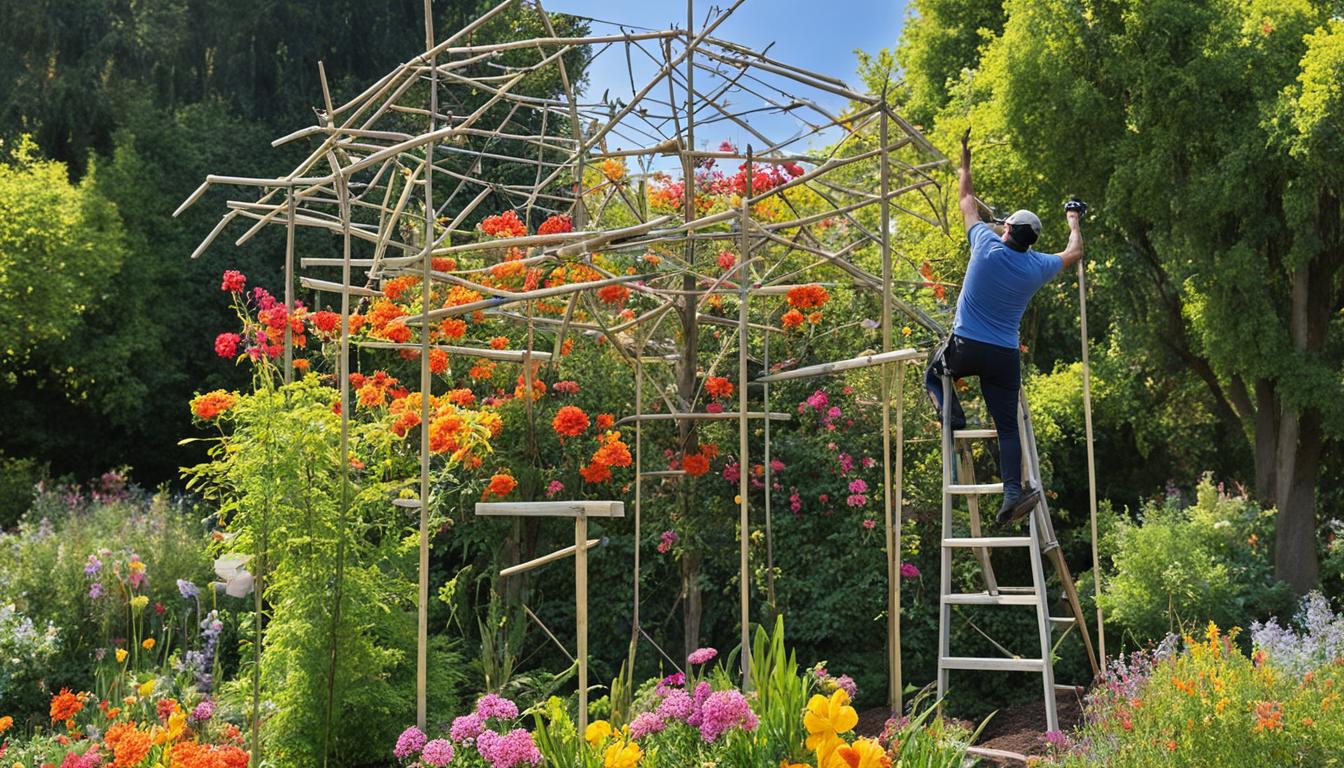
Conclusion
In conclusion, bird netting is an excellent solution for protecting your home’s garden, crops, and ponds from unwanted avian visitors. By carefully selecting the right mesh size and net material, you can create a physical barrier that effectively deters birds from accessing specific areas. Not only is bird netting safe for birds, but it also proves to be durable and environmentally friendly, making it a sustainable choice for bird control.
With its versatility, bird netting finds applications in various settings, such as gardens, agriculture, and even industrial spaces. Whether you need to safeguard your crops, fish farms, or buildings, bird netting offers a reliable defense against pesky birds. It is a valuable tool in protecting your investments and maintaining the aesthetic appeal of your property.
While bird netting has numerous advantages, it is essential to consider its limitations as well. Proper installation is crucial to ensure there are no gaps or holes that birds can exploit. Additionally, bird netting may not be cost-effective for certain facilities, and alternative methods such as physical exclusion devices or pigeon birth control options should be explored depending on the specific situation.
Ultimately, bird netting provides an effective means of addressing bird-related issues, offering a balance between protection and practicality. By becoming familiar with the different bird netting varieties, applications, and the pros and cons associated with its use, you can make informed decisions to safeguard your property effectively and maintain a bird-free environment.
FAQ
What is bird netting?
Bird netting is a physical barrier that prevents birds from accessing specific areas, such as gardens, crops, and ponds.
Why is bird netting considered effective for bird control?
Bird netting is versatile, safe for birds, and environmentally friendly. It lasts long, requires minimal maintenance, and is cost-effective.
How does mesh size impact the effectiveness of bird netting?
The mesh size of bird netting determines its effectiveness in deterring bird species. Smaller mesh sizes are more effective in excluding a wider range of birds.
What are the different types of bird netting materials available?
Bird netting can be made from materials such as polyethylene, polypropylene, and nylon, each with its own advantages and applications.
What is garden netting used for?
Garden netting is a lightweight plastic mesh used to protect gardens, fruit trees, and berry bushes from seasonal bird problems.
What is heavy-duty netting used for?
Heavy-duty netting is designed for commercial or permanent installations that require durability and high break strength.
In which applications can bird netting be used?
Bird netting can be used for crop protection, fish protection, and building protection in various settings, including gardens, agriculture, and industrial areas.
How can bird netting be used for pigeon control?
Bird netting can be used in recessed portions of buildings, light wells, under eaves, and other areas to prevent pigeons from nesting and roosting.
What are the pros and cons of bird netting?
Bird netting has advantages such as versatility and long-lasting effectiveness but may become counterproductive if there are gaps or holes. Alternatives to bird netting include physical exclusion devices and pigeon birth control options.

